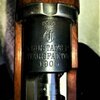If you reload for it, keep the pressures down. That rifle was more or less designed for an issue round that was operating at 3000 atmospheres, or 43,000 psia.
M1896 Infantry Rifle 29' barrel Carl Gustafs mfgr 1903
17-Aug-06 T = 85 °F
143 gr FMJ 1986 Swedish Ball
Ave Vel = 2610
Std Dev = 14.38
ES = 45.59
High = 2633
Low = 2587
Number rds = 8
 M38 Infantry Carbine 24" barrel
M38 Infantry Carbine 24" barrel
28-Oct-94 T ≈ 60 °F
143 gr 1986 Swedish Ball OAL 3.065" 47.4 grs powder average
Ave Vel = 2427
STD=22
ES = 62
Low = 2395
High = 2457
N = 10
M700 22" Barrel
143 gr Swedish Ball 1986 headstamp
2 Feb 2008 T = 54 °F
Ave Vel =2470
Std Dev =18
ES =48
High =2491
Low =2443
N =5
140 gr Hornady Spire Point 43.0 grs AA4350 R-P new brass CCI-200 OAL 2.990"
2 Feb 2008 T = 52 °F
Ave Vel = 2512
Std Dev = 27
ES = 72
High = 2547
Low = 2475
N = 5
Same load, a decade later, for comparison.
140 gr Hornady Spire Point (0.264") 43.0 grs AA4350 new R-P cases CCI 200 OAL 2.990" loaded 2-5-2000
2 Nov 2017 T=72 °F
Ave Vel =2531
Std Dev =14
ES =33
High =2540
Low =2507
N=5
140 gr Hornady SP greased 45.0 grs IMR 4831 wtd lot 2-22-2014 new R-P cases CCI 200 OAL 3.065"
2 Nov 2017 T=72 °F
Ave Vel = 2548
Std Dev =11
ES =28
High =2566
Low =2538
N =5
140 gr Hornady SP greased 45.0 grs H4831 wtd lot 01-06-2014 new R-P cases CCI 200 OAL 3.065"
2 Nov 2017 T=72 °F
Ave Vel = 2419
Std Dev = 31
ES = 88
High = 2477
Low = 2389
N = 8

three shots proves nothing about accuracy, but it is the internet standard.

I got the 140 gr bullet with 43.0 grs IMR 4350 load from a 1950's American Rifleman article which claimed it was a duplicate of Swedish ball ammunition. Velocity wise, it is a bit faster, but I think it is safe. Shoots well in more than one rifle. This is a group with a featherweight M70, not exactly a target rifle, but good enough at 300 yards.

This load is probably a little too hot for a Swedish service rifle, given the velocity is above what I received with a service load. However, IMR 4831 looks to be a real champ in this cartridge. This is at 300 yards, and I think a sub 5 inch ten shot group at 300 yards is pretty darn good for a sporter rifle.

what I mean by greased. I dip the bullet into a grease, it gets all over the case, and I shoot it.

I believe it cuts down on barrel fouling and the once fired case comes out the chamber stress free, and perfectly fireformed.

















